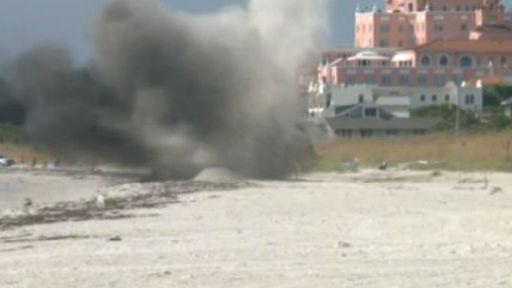Military Ordinance Dumped in Gulf of Mexico

Texas A& M oceanographic researcher have reported that unexploded bombs and other military ordnance washing up on the Florida coast has brought more awareness U.S. government materials dumping decades ago in the Gulf of Mexico could pose serious threats.
Niall Slowey, along with professor emeritus William Bryant, who have more than 90 years of combined research experience, say millions of pounds of bombs and other types of ordnance are scattered over the Gulf of Mexico and also off the coasts of at least 16 states, from New Jersey to Hawaii. The bombs can get caught in fishermen’s nets as they trawl along the ocean seafloor, or wash up on shore such as last week near the Tampa area.
The military began a massive dumping of unused bombs into the Gulf and other sites that started in 1946 and continued until 1970, when it was finally banned.
“Up until the 1960s, people thought the seafloor was beyond the reach of human activity,” explains Slowey.
“They could not imagine the types of activities that are commonplace today. As more and more of these bombs and other ordnance are discovered, it has to be assumed that they are still dangerous until proven otherwise.”
Millions of pounds -- no one, including the military, knows how many -- were sent to the ocean floor as numerous bases tried to lessen the amount of ordnance at their respective locations. The bombs included land mines standard military bombs, and also several types of chemical weapons. It is likely that some of the chemicals are leaking due to 60 to 70 years of exposure on the ocean floor, and this could pose a serious environmental threat, the researchers say.
“When exposed to air, some of these chemicals can be gaseous and can cause burns and nerve damage, and these types of cases have been reported in the Baltic Sea area where some of the most massive dumping occurred,” Slowey adds.
There have been numerous reports of fatalities caused by such bombs, such as in 2005 when three Dutch fishermen were killed when they accidentally snared a World War II bomb in their nets.
As for the Gulf of Mexico, Slowey notes that “the seafloor off the Texas-Louisiana coast is among the most active in the world, with constant activity related to energy production. It is exactly in this region where many of the munitions were dumped. As time passes, more and more people are working on the seafloor and the chance of encounter with these bombs and other ordnance is becoming greater.”
With the ship traffic needed to support the 4,000 energy rigs, along with commercial fishing, cruise lines and other activities, the Gulf can be a sort of marine interstate highway system of its own. There are an estimated 30,000 workers on the oil and gas rigs at any given moment.
Bombs used in the military in the 1940s through the 1970s ranged from 250- to 500- and even 1,000-pound explosives, some of them the size of refrigerators. The military has a term for such unused bombs: UXO, or unexploded ordnance.
One huge problem is that record keeping of the military dump sites is incomplete and sketchy at best. It’s also believed that many of the munitions were “short dumped,” meaning they were discarded outside designated dumping areas by private contractors hired at the time.
“The real mystery is that no one knows what is down there, or where all of it is,” Slowey notes.
“Although most of these bombs do not have triggers in them, some types of ordnance , such as torpedoes and mines, can become more unstable over time, so their case the chance of an accidental explosion is increasing.
“Because chemical weapons potentially pose environmental contamination risks, and because explosive material in many of the standard bombs and other ordnance may still be viable, we need to determine exactly where they are and then have a plan for removing them or at least monitoring their condition,” Slowey says.